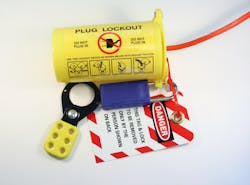Lockout/tagout (LOTO) continues to be a critical component of safety programs in manufacturing environments. The LOTO program remains one of the last lines of defense for personnel working on equipment. As workers are putting themselves at risk, they will depend on the integrity and accuracy of the LOTO program.
Gaps in LOTO can lead to serious issues. Up to 10% of serious accidents can be attributed to failure to control hazardous energy. Per OSHA, workers injured via exposure to hazardous energy lose an average of 24 work days for an incident.
Despite the potential dangers associated with LOTO, many still struggle to comply with the requirements. In fact. it is found on OSHA’s list of the “Top Ten Most Frequently Cited Standards.” So how can you tighten up your existing LOTO program? Here are six steps that can lead to a safer LOTO program.
Detail procedures
Shutdown events have been described as “immense steel jigsaw puzzles.” To help your team solve this puzzle more quickly, proper planning is critical. This includes supply chain setup, part identification, shutdown procedures and, of course, LOTO procedures.
LOTO procedures must be detailed and understandable. They should identify all equipment that is required to be locked out, where the locks should be placed and the specific energy source that is being controlled. Additionally, a description of how to test the isolation should be included.
Procedures need to be verified versus the actual situation on the floor on a periodic basis. A cross-functional task team can be formed to perform the verification process. The entire procedure must be reviewed by those with experience — and by those in leadership positions, as well.
Communication
Communication is crucial in LOTO. Whether the time is planned downtime or an unplanned shutdown, a successful lockout will depend on the communication of the different teams within the operation.
Management must communicate the importance of the LOTO program to all employees. The safety team, production team and the maintenance team must agree on delineations of responsibility. The production team must be aware of the lockout on their equipment. Lastly, the production and maintenance teams must communicate effectively about each specific LOTO process.
A CMMS program can help with communication across the different disciplines in an operation. Companies can view the CMMS schedule and prep for downtime. Procedures, including lockout procedures, can be stored in the CMMS for review before the work begins.
Communication also comes into play for the training of employees. Everyone must understand the details of LOTO and how they fit into the process. Training should involve hands-on lockout and tagout processes.
Lock out devices properly
This step may seem obvious, but this is where things can go wrong.
Electricity should be disconnected. This is often handled at the breaker or disconnect switch.
Any pressure (hydraulic, pneumatic, chemical) should be relieved from lines.
Movable parts should be blocked from movement.
Spring energy should be released.
Anything suspended should be either lowered or braced properly.
Devices used to isolate must fit criteria to carry a process load. For example, blinds used to isolate piping must be properly rated to handle system pressure.
Tags should be descriptive enough to understand. They should include a reason of the lockout, and a date. A log should be kept of all the locks and provided to the maintenance technicians performing the work.
All workers on the equipment should have a personal lock. For a complicated lockout this will go on a LOTO box, in which the individual keys will be located. This way, all involved parties must agree to remove their locks before starting up a process.
Test the locked-out devices
After the LOTO is completed, and before the maintenance work is started, perform a test on the devices. Attempt to turn them on and see if everything works. Turn switches on, attempt to turn valves, check for system pressure, etc.
This step should be your last check to ensure your LOTO was performed successfully. Do not skip this step. It will only take a small amount of time, and it can make a big difference for your workers.
Perform a safe restart
Once the maintenance work is complete, the employees can begin the process of removing locks and tags. Each affected person can remove them once they are confident the work was done well.
After the locks and tags are removed and the records are complete, the equipment can start. All workers in the area should be notified. As the equipment comes online, it should be monitored for any unusual signs of trouble.
When dealing with a complex LOTO, a restart plan should be developed before the work ends. This plan helps to establish a predetermined path for safe startup, which everyone can agree to.
Complete a downtime analysis
After the downtime is complete and the process is running, track and report the downtime. Use this downtime, along with other line downtime, to perform an analysis on your equipment. Should you be investing more in preventive or predictive measures? Should you be looking into upgrading the equipment altogether?
Review the LOTO process, the work performed and whether there were problems. Use the experience to review and adjust the LOTO process as necessary.
Conclusion
Because of the nature of LOTO and the constant focus of OSHA, your program could potentially use a review. The process should include a thorough assessment of each step of the process, with special consideration at each step. Following proper LOTO procedures will ensure that your workers are safe from potential energy sources when they are performing important downtime servicing.



